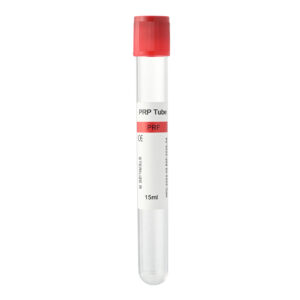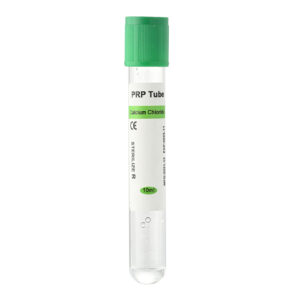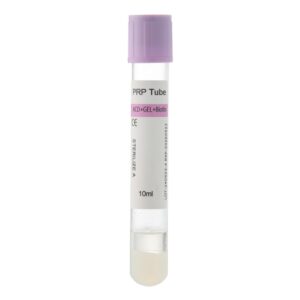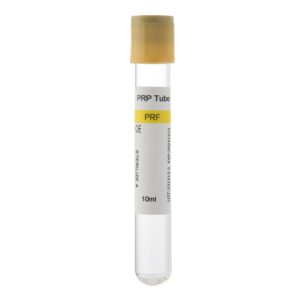Golfer’s Elbow, medically known as medial epicondylitis, is a common sports-related injury that primarily affects the wrist and forearm tendons. This condition is not limited to golfers; anyone who frequently performs repetitive hand movements, such as tennis players, weightlifters, construction workers, or office employees, can develop a Golfer’s Elbow. In recent years, Platelet-Rich Plasma (PRP) therapy has emerged as a promising treatment option for Golfer’s Elbow, thanks to advancements in regenerative medicine. This article delves into the effectiveness of PRP therapy for Golfer’s Elbow, providing a comprehensive understanding of this treatment option.
What is a Golfer’s Elbow?
Golfer’s Elbow is an inflammation and slight tearing of the tendons in the forearm caused by overuse. Specifically, it affects the tendons attached to the medial epicondyle (the inner bony bump of the elbow), which are responsible for wrist and finger flexion. Continuous stretching and pressure on these tendons trigger an inflammatory response, leading to pain, swelling, and limited functionality.
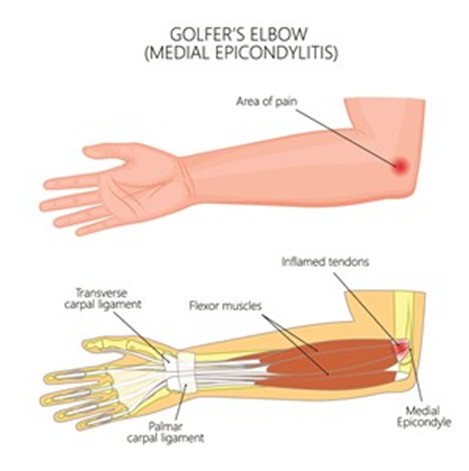
Symptoms of Golfer’s Elbow
- Pain: Inner elbow pain, especially when making a fist, rotating the wrist, or performing repetitive hand movements.
- Tenderness: Pain when touching the inner elbow area.
- Weakness: Reduced grip strength, affecting daily activities like holding objects or lifting.
- Swelling: Mild swelling around the elbow.
Causes of Golfer’s Elbow
Golfer’s Elbow typically results from the following factors:
- Repetitive Stress: Frequent hand and forearm movements, such as golfing, tennis, weightlifting, etc.
- Poor Technique: Incorrect sports posture or techniques increase tendon strain.
- Muscle Imbalance: Uneven strength in forearm muscles leads to overuse of the tendons.
- Age: Middle-aged individuals are more prone to decreased tendon elasticity.
Introduction to PRP Therapy
Platelet-rich plasma (PRP) therapy is a regenerative medicine technique that uses a concentrated form of a patient’s blood platelets to promote tissue repair and regeneration. PRP is rich in growth factors such as Platelet-Derived Growth Factor (PDGF), Transforming Growth Factor-β (TGF-β), and Epidermal Growth Factor (EGF). These factors play crucial roles in cell proliferation, differentiation, and tissue repair.
The PRP Treatment Process
- Blood Collection: A specific amount of blood (usually 10-60 milliliters) is drawn from the patient’s arm vein.
- Centrifugation: The blood is centrifuged to separate the platelet-rich plasma from other blood components.
- PRP Preparation: The concentrated platelet-rich plasma is further processed to prepare it for injection.
- Injection: The prepared PRP is injected into the damaged tendon area under ultrasound guidance.
How PRP Therapy Works for Golfer’s Elbow
PRP therapy for Golfer’s Elbow works through several mechanisms:
Promoting Tissue Regeneration
The growth factors in PRP stimulate fibroblast proliferation and collagen synthesis, aiding in the repair and regeneration of tendon tissue. This helps restore the structure and function of the damaged tendons, reducing pain and inflammation.
Anti-Inflammatory Effects
PRP has significant anti-inflammatory properties, which help reduce inflammation in the affected area and alleviate pain. Growth factors in PRP regulate the immune response and inhibit the release of inflammatory mediators, easing discomfort caused by inflammation.
Improving Blood Supply
PRP injections enhance local blood flow, providing more oxygen and nutrients to the injured tissue. This accelerates the healing process and helps remove waste products and metabolic byproducts from the damaged area, promoting the growth of healthy tissue.
Promoting Nerve Regeneration
The growth factors in PRP also support the repair and regeneration of nerve tissue, helping restore sensory function in the affected area and reducing pain caused by nerve damage.
Research and Evidence on PRP Therapy for Golfer’s Elbow
In recent years, numerous clinical studies and trials have evaluated the effectiveness of PRP therapy for Golfer’s Elbow. The results consistently show that PRP therapy offers significant advantages in pain relief and functional recovery compared to traditional conservative treatments.
Randomized Controlled Trials
Randomized controlled trials (RCTs) are essential for assessing the effectiveness of PRP therapy. These studies typically divide patients into two groups: one receiving PRP therapy and the other receiving traditional conservative treatments. The results indicate that patients treated with PRP experience greater pain relief and better functional recovery, with effects lasting longer than those treated with conventional methods.
Long-Term Follow-Up Studies
Long-term follow-up studies track patients over extended periods to assess the durability of PRP therapy’s benefits. These studies have shown that PRP therapy not only provides short-term pain relief but also maintains good functional status over the long term, significantly reducing the rate of disease recurrence.
Meta-Analyses
Meta-analyses combine results from multiple studies to provide more robust conclusions. These analyses have found that PRP therapy significantly improves clinical symptoms and functionality in patients with Golfer’s Elbow. Compared to conservative treatments or corticosteroid injections, PRP offers better long-term outcomes.
Mechanistic Studies
Laboratory research has uncovered the molecular mechanisms by which PRP promotes tissue repair. Studies show that the growth factors in PRP activate various signaling pathways that enhance cell migration, proliferation, and differentiation, speeding up tissue regeneration. Additionally, PRP modulates the local environment to suppress inflammatory responses, creating favorable conditions for tissue healing.
Advantages and Limitations of PRP Therapy
Advantages
- Non-Surgical: PRP therapy is a minimally invasive treatment, avoiding the risks and recovery time associated with surgery.
- Autologous Treatment: Using the patient’s blood reduces the risk of immune rejection and infection, enhancing treatment safety.
- Promotes Natural Healing: By stimulating the body’s repair mechanisms, PRP accelerates the healing process and reduces reliance on external medications.
- Versatile Applications: PRP is not only effective for golfer’s elbow but is also widely used for other tendon injuries, arthritis, and soft tissue damage.
Limitations
- Individual Variability: Patients may respond differently to PRP therapy, with some experiencing less noticeable benefits.
- Higher Cost: PRP therapy is more expensive than traditional conservative treatments, which might be a financial burden for some patients.
- Multiple Treatments: Achieving optimal results may require multiple injections, increasing the overall treatment time and cost.
- Lack of Standardization: PRP preparation methods, platelet concentrations, and injection dosages are not yet fully standardized, leading to variations in treatment outcomes.
Indications and Contraindications for PRP Therapy
Indications
- Chronic Golfer’s Elbow: Cases that do not respond to conservative treatments.
- Acute Tendon Injuries: Recent tendon tears or inflammation.
- Other Tendon Inflammations: Such as tennis elbow or Achilles tendinitis.
- Arthritis: Chronic inflammation in joints like the knee or shoulder.
Contraindications
- Blood Disorders: Conditions like hemophilia or other bleeding disorders.
- Infected Areas: Active infections or skin infections at the injection site.
- Pregnancy: Due to incomplete safety data, pregnant women should use PRP therapy cautiously.
- Autoimmune Diseases: Conditions like systemic lupus erythematosus require medical supervision before using PRP.
PRP Treatment Steps and Precautions
Treatment Steps
- Initial Assessment: A professional doctor evaluates the patient to determine suitability for PRP therapy and rule out contraindications.
- Blood Collection and Preparation: Blood is drawn from the patient’s vein under sterile conditions and centrifuged to prepare PRP.
- Injection Preparation: Using ultrasound or other imaging guidance, the injection site is identified to ensure accurate placement.
- Injection Procedure: PRP is slowly injected into the damaged tendon or joint to ensure even distribution.
- Post-Treatment Care: Patients should avoid overusing the affected area and follow the doctor’s rehabilitation advice.
Precautions
- Pre-Treatment Preparation: Avoid taking anticoagulants or nonsteroidal anti-inflammatory drugs (NSAIDs) before treatment to prevent affecting PRP efficacy.
- Post-Treatment Care: Mild pain or swelling may occur after injection; rest and avoiding strenuous activities are recommended.
- Regular Follow-Ups: Follow the doctor’s schedule for check-ups to assess treatment effectiveness and determine if additional treatments are needed.
- Lifestyle Adjustments: Modify daily and work habits during recovery to avoid repetitive stress and promote tendon healing.
Technological Innovations
- Multifunctional PRP: Adjusting platelet concentrations and adding growth factors to create more targeted PRP products.
- Nanotechnology: Enhancing PRP stability and penetration using nanotechnology to boost treatment outcomes.
- Smart Injection Devices: Developing intelligent injection devices for more precise and controlled PRP administration, improving safety and efficacy.
Expanded Clinical Applications
- More Disease Indications: Exploring PRP use in Nerve Injuries, skin wounds, and bone healing.
- Personalized Treatment: Tailoring PRP therapy based on individual patient conditions to maximize effectiveness.
- Combination Therapies: Combining PRP with other treatments like physical therapy or medications to enhance overall treatment results.
Patient Case Studies
Case Study 1: Athlete Mr. Li
Mr. Li, a professional golfer, developed severe Golfer’s Elbow pain due to intense training and competitions. Traditional conservative treatments failed to provide relief, leading him to opt for PRP therapy. After two PRP injections, Mr. Li experienced significant pain reduction and regained normal forearm strength, allowing him to return to competitive play.
Case Study 2: Office Worker Ms. Zhang
Ms. Zhang developed Golfer’s Elbow from long hours of computer work, impacting her daily life and work performance. Following PRP therapy and a month of rehabilitation exercises, her symptoms significantly improved, enhancing her work efficiency and quality of life.
About Us
We are a professional medical supplies company dedicated to providing high-quality medical products and expert technical support to our customers. Our team possesses extensive industry experience and deep professional knowledge, ensuring that every customer receives satisfactory service. Whether you are a medical institution, clinic, or individual user, we offer the most suitable products and solutions for your needs.
Our Advantages
- Diverse Product Range: We cover a wide range of medical supplies to meet various medical needs.
- Quality Assurance: Strict quality control systems ensure the safety and effectiveness of every product.
- Professional Support: Our experienced technical team provides comprehensive support and after-sales service.
- Fast Response: Efficient logistics systems ensure the timely delivery of products to our customers.
Tags
PRP Therapy, Golfer’s Elbow, Medial Epicondylitis, Sports Injury, Medical Supplies, Tissue Repair, Pain Relief, Regenerative Medicine, Tendon Inflammation, Platelet-Rich Plasma
Conclusion
Golfer’s Elbow is a common sports injury that significantly impacts daily life and athletic performance. PRP therapy, with its unique regenerative capabilities, has become a highly regarded treatment method in recent years. Current research indicates that PRP effectively alleviates pain, promotes tendon repair, and improves functionality. However, due to individual differences and varying research outcomes, the effectiveness of PRP therapy can vary from person to person. Before opting for PRP therapy, patients should thoroughly discuss with professional doctors to understand their specific conditions and the pros and cons of the treatment, thereby formulating the most suitable treatment plan.
As medical technology continues to advance and more high-quality studies are conducted, PRP therapy is expected to become a standard treatment for Golfer’s Elbow and other tendon injuries in the future. For patients seeking non-surgical, natural treatment options, PRP undoubtedly offers a powerful choice. Our company remains committed to staying abreast of developments in regenerative medicine, providing our customers with the latest and highest quality medical supplies to support the advancement of medical care and improve the health of more patients.


